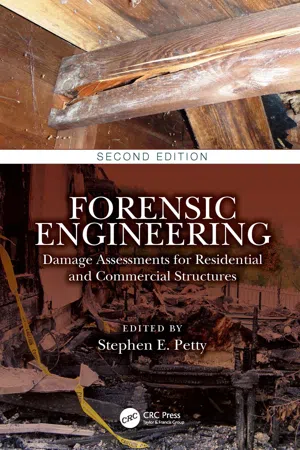
Forensic Engineering
Damage Assessments for Residential and Commercial Structures
- 732 pages
- English
- ePUB (mobile friendly)
- Available on iOS & Android
Forensic Engineering
Damage Assessments for Residential and Commercial Structures
About This Book
Serving as a comprehensive resource that builds a bridge between engineering disciplines and the building sciences and trades, Forensic Engineering: Damage Assessments for Residential and Commercial Structures, Second Edition provides an extensive look into the world of forensic engineering. Focusing on investigations associated with insurance industry claims, the book describes methodologies for performing insurance-related investigations, including the causation and origin of damage to residential and commercial structures and/or unhealthy interior environments and adverse effects on the occupants of these structures.
Edited by an industry expert with more than 40 years of experience and contributors with more than 100 years of experience in the field, the book takes the technical aspects of engineering and scientific principles and applies them to real-world issues in a nontechnical manner. The book provides readers with the experiences, investigation methodologies, and investigation protocols used in and derived from thousands of forensic engineering investigations.
FEATURES
-
- Covers 24 topics in forensic engineering based on thousands of actual field investigations
-
- Provides a proven methodology based on engineering and scientific principles, experience, and common sense to determine the causes of forensic failures pertaining to residential and commercial properties
-
- Includes references to many codes, standards, technical literature, and industry best practices
-
- Illustrates detailed and informative examples utilizing color photographs and figures for industry best practices as well as to identify improper installations
-
- Combines information from a multitude of resources into one succinct, easy-to-use guide
This book details proven methodologies based on over 10, 000 field investigations in which the related strategies can be practically applied and appreciated by both professionals and laymen alike.
Frequently asked questions
Information
1 Introduction
Contents
- Define the term “Forensic Engineering” and explain why forensic engineering is needed.
- Define areas within the insurance industry where forensic engineering services are often required.
- Define a standard forensic engineering inspection protocol.
- Explain why written reports are needed along with key elements of the basic forensic report.
- Define how to use the terms “not possible,” “possible,” “probable,” “likely,” and “certain.”
- Understand where forensic engineering services are likely to be needed, especially by the insurance industry.
- Be able to conduct a forensic inspection using a standard protocol.
- Recognize the value and key components of a written forensic inspection report.
- Know and understand when and how to use the terms “possible,” “probable,” “likely,” and “certain.”
1.1 Definition of Forensic Engineering/Sciences
- What are the failure(s) or condition(s) of concern?
- What are the magnitude and extent of the failure(s)?
- When did it occur (if this determination is needed and desired)?
- Why did it occur?
Table of contents
- Cover
- Half Title
- Title Page
- Copyright Page
- About the International Code Council
- Dedication
- Table of Contents
- Preface to the Second Edition
- Acknowledgments
- Editor
- Contributors
- Chapter 1 Introduction
- Chapter 2 Hail Fundamentals and General Hail-Strike Damage Assessment Methodology
- Chapter 3 Hail Damage Assessments for Residential and Light Commercial Exterior Finished Surfaces and Steep-Slope Roof Systems
- Chapter 4 Hail Damage Assessments to Low-Sloped Roof Systems
- Chapter 5 Synthetic Storm Damage (Fraud) to Roof Surfaces
- Chapter 6 Wind Damage Assessments for Residential and Light Commercial Roofing Systems and Finished Surfaces
- Chapter 7 Wind Damage Assessments for Low-Sloped Roof Systems
- Chapter 8 Water Infiltration – Cause and Origin Assessments Steep- and Low-Sloped Roof Systems
- Chapter 9 Water Infiltration – Cause and Origin Assessments Exterior Residential and Light Commercial Building Envelope
- Chapter 10 Water Infiltration into Basements
- Chapter 11 Indoor Environmental Quality
- Chapter 12 Attic and Crawlspace Ventilation
- Chapter 13 Mold and Bacteria
- Chapter 14 Forensic Inspection Assessments of Residential Wood Framing Systems
- Chapter 15 Forensic Inspection Assessments of Foundation Walls
- Chapter 16 Forensic Inspection Assessments of Brick Masonry Chimneys, Veneer Walls, and Porches/Decks
- Chapter 17 Fire Damage Structural Property Assessments
- Chapter 18 Vehicle Impact Structural Property Assessments
- Chapter 19 Tornado-Related Structural Property Damage Assessments
- Chapter 20 Blast and Explosion Damage Property Assessments
- Chapter 21 Lightning Damage Property Assessments
- Chapter 22 Plumbing/Piping/Tubing Failures
- Chapter 23 Equipment Failures and Investigations
- Chapter 24 Serving as an Expert Witness
- Index